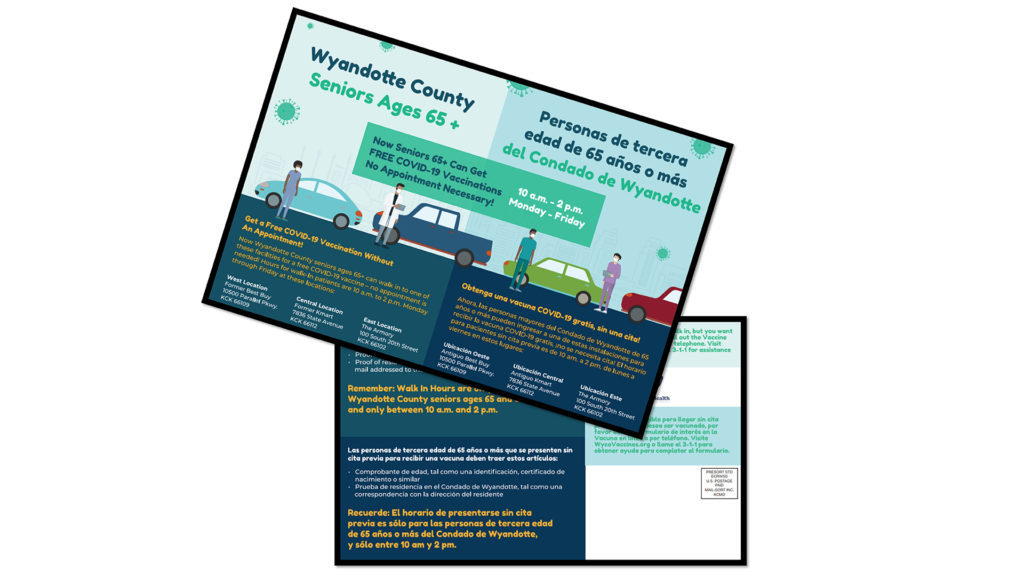But changing your message isn’t always the answer. Sometimes the key is in your delivery.
If you’re relying on tactics that take advantage of only one or two of the channels your audience consumes, there’s a chance that when the unexpected strikes, these tactics will fall short of their overarching objectives. If this has happened to you, then you may be wondering—what now?
One solution is to use integrated communications to preserve your key messages and adapt them for a variety of channels to surround your audience where they are. Essentially, you’re telling the same story through a number of different media types to break through the clutter and make your brand ever-present in the eyes and ears of your audience.
Not only does an integrated marketing strategy give you more chances to be seen, but it also allows you to reach members of your audience multiple times to make it difficult—or even impossible—to tune out what you have to say. The results are increased engagement, heightened brand recognition and, if your messages are compelling, improved sales.
At Mod Op, integrated marketing allows us to tell your story in a more personal and meaningful way. It even gives us the space to get creative in solving your challenges and accomplishing your goals. These campaigns don’t just get seen; they make the headlines. This was certainly the case when we partnered with the United Government of Wyandotte County, Kansas to launch a massive, public awareness campaign that led to over 56,000 people receiving their COVID-19 vaccine by June 2021.

When COVID-19 first hit the United States in March 2020, Mod Op was already working with the Unified Government on a strategic communications program. Like many municipal organizations, the Unified Government received hundreds of questions flooding in from both the community and the press in the Kansas City area.
“For a lot of the public information officers, COVID completely changed their job description,” says Mod Op Public Relations Manager Sally Behringer. “They went from a job where they might get a media inquiry maybe once a week to a daily barrage of, ‘Has anybody died yet?’”
With such a sharp spike in the demand for communications, the Unified Government was under pressure to mobilize enough messaging to maintain a positive relationship with their stakeholders and roll out their new health policies. They turned to Mod Op for help in developing an integrated marketing campaign that would bridge the gaps in their communications strategy.
As Behringer led the charge on the public relations front, our creative and paid media team designed outdoor signage, radio and television spots, and direct mail, both in English and Spanish, encouraging the people of Wyandotte County to stay home, wear masks and get their vaccine to prevent the spread of COVID-19. We took advantage of every communications channel available to us, including newspapers, social media and sporting events, to reach out to a much wider audience and make our message unavoidable. Throughout the campaign, we featured local faces to foster a deeper and more meaningful connection between the Unified Government and the community.

“It’d be difficult to go anywhere and not see some sort of COVID-19 messaging from the health department,” says Mod Op Account Director Aaron Gilbertie. “You walked to the bus; you saw a vinyl wrap on the bus. You got on the bus; it was on a 15 second audio that ran at every stop. You drove anywhere; you saw billboards.”
The campaign was a huge success. As of June 2nd, health officials have administered more than 100,000 doses of the vaccine at Wyandotte County’s vaccination facility, and fewer than 300 county residents have died from the disease. The campaign was featured by several local news outlets, including KSHB, Wyandotte Daily! and The Kansas City Star.
Whether you’re gearing up for your next product launch or just want day-to-day messaging that resonates, consider how you can use integrated communications to be everywhere your audience turns. You’ll make your presence known, and, more importantly, you’ll see significant returns on your investment, regardless of your budget.
Surrounding audiences with compelling marketing messages is what we do everyday. Click here to learn more about our services.
The Latest
We study the game as hard as we play it.
Learn with us what’s now and next.
Related Stories

That’s why we’re pleased to announce that, this year, we received the CMA Award for Best Overall Design in Digital for our exceptional work on the relaunch of Belvedere Vodka’s website.
Mod Op and Belvedere have worked together since 2015. As an agency, we’ve always strived to improve and innovate the work that we do with new, disruptive, creative solutions that give our clients a competitive edge.
As we continued to work closely with Belvedere, we saw an opportunity to optimize their site and enhance the user experience to better align with their position as an organic vodka that’s “Made With Nature.” Not only would the site tell a more meaningful and immersive brand story, but it would do so in a way that reflected the premium look and feel that defines Belvedere Vodka.
With these ambitions in mind, we began the project to relaunch the Belvedere website with goals of capturing more traffic, captivating their audience and converting more users into customers.
Optimizing, redesigning and relaunching Belvedere’s website was no small undertaking. Pulling experts from across a wide range of disciplines, we put together a team of designers, developers, QA specialists, content authors, SEO strategists, copywriters and analysts that worked together to streamline the site design and enhance the visual experience so we could improve the user journey.
We decided to build the new website using a headless Drupal, react-based interface that connects to a custom CMS to optimize performance. And, instead of designing the site as a group of pages, we broke each page into individual modules, which can be repurposed and rearranged for future content. The result is a simple design that is not only more flexible, but also more sustainable, allowing Belvedere to put out new content with a shorter time to market and no need to invest more in their site design.
A beautiful design calls for captivating visuals. We integrated gorgeous, full-screen video content, photography, micro animations and seamless scrolling into the site’s visual design to delight the user and immerse them deeply into the ebb and flow of nature. Along with these visuals, we crafted tasteful, sophisticated, SEO-optimized messaging that tells the unique story of Belvedere, a fire-distilled, organic vodka made with Polish rye and purified water.
Finally, we added new, engaging features to Belvedere’s website to give the site utility and direct more visitors into the content funnel. We worked with a third party to integrate a new app called the “Virtual Mixologist,” allowing users to search for organic cocktails for specific occasions or for recipes that include the ingredients they have at home. We also added new “occasions” to the site, pages that feature cocktail recipes for a specific season, meal or celebration, allowing visitors to quickly find the cocktail recipes they need while linking them directly to the product.
The site relaunched in September 2020, fulfilling every one of our expectations. With massively improved performance and faster load times.
The new site also captured much deeper engagement with Belvedere’s audience. Users spent significantly more time per page view and explored more pages per visit. And with more pathways for visitors to become customers, the site delivers a continuous return on Belvedere’s investment.
Building innovative brands is what we do. Let’s work together to tell your story.
The Latest
We study the game as hard as we play it.
Learn with us what’s now and next.
Related Stories
TAKE A DIGITAL MATURITY EVALUATION
Most companies don’t lack for good ideas for improving customers’ experiences and satisfaction with their digital products or services. But often there are hurdles, communication errors, and other obstacles that block the translation of those ideas into successful implementations of product strategy.
As a leader, how can you ensure that your product reaches the finish line successfully?
Here are five ways CEOs and other leaders can ensure their strategies are driven through to successful execution.
Let nothing come between you and your customer – including your company
Many companies rely on internal team members to serve as internal translators of their customer’s needs and pain points. Whether that be salespeople or marketers or even founders and executives – yes, any number of these employee groups can gather great insight. However, nothing can substitute the direct feedback from your customers and prospects on their ever-changing needs.
According to research from Salesforce, 63% of consumers expect businesses to know their unique needs and expectations, while 76% of B2B buyers expect the same thing.
Conducting regular surveys and interviews is a good place to start. Make sure to address both general pain points and needs and specific queries regarding your products and the competition. In doing this, you equip your product and technology teams with key insights that feed the product implementation roadmap.
One especially useful approach is to seek understanding about all customers’ workflow, or what some marketers might call the customer or buying journey. What do they do just before, during and after they use your product? This helps you understand why customers make the choices they do – which is key to product innovation.
Present a clear and focused product strategy
Once you’ve identified and understood your customers’ needs and pain points, it’s time to distill a strategy with a clear, realistic number of elements. Stick to half a dozen or less – anything more than that will likely result in your company’s efforts being too divided and scattershot to drive the results you are looking for.
It is often best to start with a positioning statement that aligns the idea with business goals, measured by key performance indicators (KPIs). Then make sure the product team aligns every feature to support that positioning statement and its goals.
Separate the product from the technology
There are a number of popular phrases in the technology world that can lead people to think that speed is the way to product quality. Words such as “agile,” “nimble” and “failing fast” may be applicable in some instances, but may cause more harm than good. As a result, we often see leaders trying to be “agile” but end up throwing money and resources into concepts that are half-baked, ineffective or too expensive to do well quickly.
Make sure your product team first tests the concept, then builds the technology later.
Keep in mind that the technology is not the end result – it’s what the technology makes possible for the end customer that establishes the need for your product!
Think about what you are trying to do and use as few technology resources as possible to get it in front of your customer. Once you start to see engagement, then build the technology.
Manage your product team’s priorities
Once you have your customer pain points identified and a focused product strategy, it’s important to stay focused. In fact, the most important thing you can do for your product organization at this time is to help them manage priorities and remain focused on the core problem.
Avoid being distracted by “shiny objects” – those enticing things technology vendors promise, or competitors may be trying, but have little relevance to your own strategy.
Be brutal about eliminating non-performing products. In short, keeping people in the product organization from feeling they are constantly taking on new initiatives without offloading other, less important tasks is one of the most important things a CEO can do.
Ensure stakeholder collaboration
Does your organization’s product team operate in a silo? Do your marketing and sales leaders participate in product ideation? Do they feel involved in the process and bought in to the results? If you see aspects of silo behavior it is important to encourage cross-functional stakeholder engagement.
Interested in product strategy and execution? Here are some additional insights from our team that you may find helpful:
- Use “design thinking” like a tech giant
- Looking back from the future
- Transforming? Be sure to synchronize product, platform, and brands
Of course, you can always let us know if you’d like to set up a chat.
TAKE A DIGITAL MATURITY EVALUATION
The Latest
We study the game as hard as we play it.
Learn with us what’s now and next.
The overall goal of these updates is to improve Google’s ability to provide searchers with content they can trust, which involves a better understanding of what a searcher is looking for and enhanced recognition of the quality of content.
Google released core updates last year. In this two-part blog post, I’d like to share some insight on significant changes implemented during these two updates and how you can adapt your digital marketing strategy to complement them. In this first part, we’ll focus on the update’s emphasis on content relevancy and the principle of E-A-T.
Content Relevancy
The primary change of the May 2020 update had to do with content relevancy and Google’s ability to recognize it. Google is now better able to determine how relevant and useful any given piece of content is.
If your content was more relevant in May 2020 than it was in January 2020, you’re in luck, and your site probably improved in search engine results. However, if you have outdated content, your website most likely dropped in Google rankings post-update. We recommend clients focus more attention on blogging as a natural way to continually post timely content to their sites, thus improving Google’s perception of their content relevancy. You may find a few handy tips on doing so in this article about refining your blog.
This particular upgrade emphasizes the importance of revising old content, as well as publishing new, to keep your information accurate and your digital marketing strategy current. When your marketing includes relevant content, Google will recognize it as useful for searchers and rank it higher in search engine results.
E-A-T
Google uses the abbreviation E-A-T to discuss expertise, authoritativeness and trustworthiness. These qualities are crucial in Google’s ranking algorithms, and both the January and May updates focused on E-A-T.
E-A-T connects to many aspects of your business, including your content and brand. It’s especially critical to work on your E-A-T if your industry is YMYL or Your Money or Your Life. YMYL websites are medical, legal or financial sites, any site that helps its users make important decisions and any site that sells products or processes credit card payments, which is pertinent for all eCom focused sites.
YMYL sites understandably need to be trustworthy. After all, you wouldn’t want medical advice from someone not licensed or knowledgeable enough to give it. If you do run a reputable site, you want to make sure Google recognizes it as such. A digital marketing agency like ours can help you refine your brand in order to boost your E-A-T. This post about how we rebranded the Oxygen channel is a great example of how we’ve improved a client’s E-A-T in the past.
Here at Mod Op, we can help optimize your content and your E-A-T as two means of modernizing your SEO strategy, and those are just the beginning. Next month, in the second half of this analysis, I’ll cover three more areas that Google’s recent updates address. In the meantime, you can learn more about Mod Op’s SEO and other technology services here.
The Latest
We study the game as hard as we play it.
Learn with us what’s now and next.
Related Stories
TAKE A DIGITAL MATURITY EVALUATION
Most business leaders today know the word “platform” has morphed beyond its traditional Oxford English Dictionary definition as either “a raised level surface on which people or things can stand” or “the declared policy of a political party or group.” When a recent U.S. president got “de-platformed,” most of us understood that meant he was kicked off Twitter and other major social media websites.
But fewer executives fully understand what the term means in the business world, or why they might need one. Searches for the phrase “digital platform” hit a new peak last September, with the term doubling in interest since October 2019, according to Google Trends.

To help you more effectively incorporate these key insights into strategic conversations, we first need to define what is meant by a “digital platform”, and then discuss how to establish a digital platform strategy and why you need to adopt a platform mindset to be successful in today’s digital economy.
What do we mean by ‘digital platform’?
Think of it like an ecosystem: A digital platform is a combination of culture, services, data and technology upon which additional innovation and value can be rapidly and efficiently delivered.
Digital platforms can add value by enabling service innovation for customers and clients, fostering more efficient ways of working, revealing new insights from operational data – or likely a combination of all three.
A recent Deloitte study on the topic describes four categories of digital platforms:

Business platforms can embrace any combination of these categories. But what’s common is a mindset that values creating an environment in which customers can learn about and consume your products and services. Companies like Salesforce build platform businesses that enable customers and partners to create additional value on top of their platform.
Other organizations like Netflix and Uber use a platform strategy to accelerate internal delivery of services and value to consumers. In both cases the necessary ingredients for a successful digital platform approach remain the same.
Successful adoption of a digital platform business model requires:
- An adaptable and problem-solving staff
- Clarity regarding the core set of services shared across teams and organizations
- Understanding of the centrality and importance of data as the lifeblood asset of the company
- An integrated, scalable, agile and reliable technology foundation
Digital platforms – the basics
The graphic below shows the elements that comprise many modern digital platforms. These models are best read from the bottom up: User profile data, web content and other data power a series of services, which drive front-end business applications for the user.
These applications and services are presented via a common user interface.

Why growth depends on a digital platform strategy
Organizations with platform-based business models have a number of inherent advantages over organizations with a more traditional structure and operating model. Product development is typically faster because building on top of shared platform services accelerates implementation cycles. It also accelerates the speed which new services and features can be released based on real customer evidence and feedback.
Decision-making is also faster using a platform approach over traditional, hierarchically governed organizations. Central is the notion of continuous improvement based on a recurring feedback loop:

Capturing a growing share of revenue enables more aggressive reinvestment in underlying platform capabilities, which reinforces the built-in advantage of the positive digital platform feedback loop. Organizations that optimize and build on these platform-enabled feedback processes tend to pull away at an increasing rate from their more traditional competitors.
Adopting a digital platform culture
Platforms differ from traditional business models by emphasizing horizontal integration of data, processes and services across organizational boundaries. Traditional business models depend on hierarchical decision-making and emphasize specialization and ownership within functionally distinct organizational boundaries.
Platform-based approaches typically require a flatter organization with networked collaboration and decision-making processes that focus on responsiveness by pushing decision-making authority closer to the point of engagement with the customer or client.
The imperative to push decision making away from traditional hierarchical leadership roles toward empowered and enabled members of staff places a premium on adaptability, higher level problem solving and analytical skills.

Successful digital platform organizations hire talent that can flex between different roles and can continuously develop new skills and capabilities. These organization focus on empowering staff to make decisions based on data with readily available access to the data and required analytical tools.
Data: The lifeblood of digital platform-based business models
Accurate, real or near real-time operational data is the foundation of fast, precise decision making. It all leads to better product and service designs, and continuous improvement in business operations efficiency.
Platform-based businesses invest heavily in the technical data landscapes that provide a 360-degree view of the business and are able to ingest, process and distribute data as efficiently as possible to the staff and systems driving the business forward.
Continuous, ongoing Investment in the analytics tools required to use data to inform business decisions is critical.
Creating standard services for your business platform
One of the keys to driving growth with a platform business model is the ability to identify common processes across the organization and to turn these into shared automated services within the technical landscape.
The creation of a set of common shared platform services fosters two significant benefits for the organization.
- Benefit 1: Decision-making and transactional friction is dramatically reduced by adopting standard service definitions.
- Benefit 2: Time-to-market to introduce new products and services is radically improved by building new capabilities from a reusable set of “Lego” building blocks.
Technology basics for powering a digital platform business
Platform-based businesses almost always base their technical architectures on modern cloud-based, scalable design and operating principles. The elastic nature of cloud-based architectures and the ease with which integrated data landscapes can be provisioned and operated makes these the optimal environments for delivery and management of digital platform services.
Some of the world’s largest and most successful platform companies – including Netflix, Facebook, Twitter, Uber and Spotify – make much of their platform capabilities available via open-source code. Organizations embarking on building out platform-based technical infrastructures can accelerate their journey by reusing the building blocks made freely available by these companies and others.
Building these technical platform capabilities from scratch often does not make sense for an organization.
Fortunately, there are an increasing number of very sophisticated and fully managed platform services available from the main cloud platform providers, such as Amazon Web Services, Microsoft Azure and Google’s Cloud Platform. Adoption of a technical architecture and landscape based on these fully managed services radically reduce an organization’s need to invest in technical operating capabilities and the associated fixed in-house costs.
The advantages of developing a digital platform business model are increasingly clear to all types of businesses and organizations who are committed to growth, innovation, and defining the future for their customers and marketplaces. Success depends on developing the organizational rigor and internal operating discipline to embrace required change and effectively develop and execute an enterprise-wide platform approach.
Wondering how can you apply the thinking behind digital platforms for your enterprise? Let us know if you’d like to chat further.
The Latest
We study the game as hard as we play it.
Learn with us what’s now and next.
TAKE A DIGITAL MATURITY EVALUATION
Effective deployment and use of digital tools and services underpins the success of every organization today. But while the right technology can give you a competitive advantage, most organizations find it difficult to keep up with the sheer pace of technology change. Finding the appropriate level of investment in digital tools, skills, and processes is among the most pressing and challenging issues for today’s leadership teams. These challenges can be faced head-on and often overcome by conducting a thorough technology assessment.
Regular technology assessments ensure continued strategic alignment between business strategy and digital investments. When undertaken effectively, a technology assessment will:
- Improve business operations
- Enhance customer service
- Reduce time-to-market for new products and services and, most critically
- Ensure your organization’s capabilities enable future growth and mission objectives
When should you conduct a technology assessment?
Frequently reviewing your technology landscape will allow you to track progress in aligning your capabilities to the evolving needs of your operating model. And by regularly assessing technology capabilities, you’ll maintain a clear investment roadmap that aligns the stakeholders and partners who drive and benefit from those investments.
Other signs that it’s time to perform a strategic technology assessment include:
- When considering a major technology investment
- When your business is experiencing significant, above-normal growth
- When market dynamics change due to disruptive use of digital strategies by competitors

There are three steps to a typical technology assessment. Let’s talk about them:
1. Analyze Your Current Technology State
As with any decision-making process, there has to be an information gathering and analysis of data. It doesn’t have to be a cumbersome and painstaking process. If done right, the analysis can be quick and effective.

While you can try to do this step on your own, experience tells us that you’re likely to get blinded by two factors: confirmation bias and, if you’re not a CTO, lack of experience. Enlisting outside help is common for many organizations.
It’s essential that these technology assessment interviews are conducted by an experienced CTO with the deep operational experience needed to ask the right questions and use insight to separate the aspirational from the actual. An outside perspective also helps keep things objective, so confirmation bias doesn’t creep in — where the search becomes only for the information we want to find.
In these assessments, you’ll also want to review data architecture and management practice, development capabilities and technology delivery processes, compliance processes, licensing and 3rd party services portfolio, and operational playbooks and processes..

When this step of the technology assessment is complete, you’ll have a clear picture of the baseline capabilities along with a better understanding of potential gaps between what was expected versus what’s actually there in terms of people, process and technology.
2. Diagnose Your Technology Needs
With the analysis complete, it’s time to map the current-state portfolio of capabilities to strategic business and market growth objectives. This allows you to prioritize among the various technology implementation options and create a phased schedule for any investments.
From there, the next step will be to identify gaps or misalignment in capabilities, technology operating plans, service portfolios, technical architecture and platform strategies.

Once the diagnostic phase is wrapped, you should have an understanding of where the opportunities lie and where you may have potential gaps in technology capabilities.
3. Align Your Technology Plan
The alignment phase is where it all comes together. In this phase, you’ll need to develop a plan to address gaps likely to impact growth or undermine investment hypotheses, including:
- Forward-looking viability
- True ability to scale
- Compliance
- Governance
- Security
- Other identified risks
If you work with a team like Mod Op Strategic Consulting, this is the stage where you’ll get a detailed report that includes a roadmap for practical, risk-mitigated, technology capability enhancement. If you’re attempting this on your own, you’ll want to make a report so you can share it with your team and plan next steps.
Upon completion of the three technology assessment phases, you should have a 360-degree view of your technology capabilities from the perspective of:
- Hardware
- Software
- Networking
- Data
- People and processes
All with clear recommendations for mitigations and other changes needed.
Ready to Schedule Your Technology Assessment?
Over the last several years Mod Op Strategic Consulting (Mod Op Strategic Consulting) has led technology assessments for dozens of clients. With these quick and effective technology assessments, led by our CTO, we take care of each phase resulting in a comprehensive blueprint to help you align your business strategy with your digital investments.
If you’re due for a technology assessment, grab a copy of our technology assessment checklist, and reach out to our team for a free consultation call.
The Latest
We study the game as hard as we play it.
Learn with us what’s now and next.
If you’ve spent any time in PR, you’ve heard an executive vice president or two reminisce about the days of writing releases on typewriters and clipping media hits by hand. Those anecdotes, better than anything else, showcase just how much the discipline has evolved over the last few decades. My point is that things are constantly changing. But one thing that has remained the same is the need to get high-quality coverage for clients. You’ve distributed releases and secured articles, but have you thought about podcasts?
An intro to podcasts
Since their rise to popularity in the early 2000s, podcasts have been on the up and up. According to insights from Nielsen, the podcast audience in the United States is projected to double by 2023. This portable, on-demand option is becoming the preferred method of entertainment and catching up on current events during long commutes to and from the workplace. Although many have moved to working from home due to the COVID-19 pandemic, the data shows that smart speakers are also being widely used for listening.
Leveraging podcasts for PR
The beauty of podcasts is that they can be used in a variety of ways. PR practitioners can help secure guest spots or even create a client-branded show.
Before trying to create a podcast, consider setting up interviews on industry-leading shows. Because existing channels are likely to already have their set target audience, you can focus on the topic at hand and building awareness for your brand, not for the podcast itself. Capitalize on the already curated audience as well as the trusted host, while also getting your message out there. Here, the emphasis is credibility. Unlike a press release which might be viewed as bias, an interview or article featuring your company gives weight to your brand by having a trusted authority figure provide validation. The same concept applies with podcasts.
Creating your own podcast and building an audience can help establish your company as a thought leader in your desired industry. This takes the opportunity from earned to owned. In this case, you have all the power when it comes to creating and attracting an audience, selecting topics for each episode and discussing details specific to your company. This also puts the company, specifically the host, in a position to be a thought leader and feature other well-known thought leaders on the show.
After the interview
After securing an interview on a podcast, or even starting your own, don’t just leave it at that. Leverage it wherever possible. Share the link on your own social channels or reshare posts from the podcast’s pages and encourage followers to take a listen. This way, you’re cross-promoting and reaching a wider audience. If it makes sense, link to the podcast on your website so potential customers can feel confident in your expertise.
Lastly, use it as part of your next podcast pitch. Mentioning another podcast in a pitch and providing a link to listen helps the host understand what you’ve discussed before, your interview style and what your area of expertise is.
Yes, PR has come a long way, and is still changing, so don’t get left behind. Stay ahead of the curve. Seek out new and relevant opportunities for your company, understand where your audience is and how they can be reached, and partner with a skilled agency to ensure you’re not neglecting your target audience.
The Latest
We study the game as hard as we play it.
Learn with us what’s now and next.
Related Stories
In addition to navigating these troubled waters, platforms are becoming more data-shackled, as governments are raising their brows when it comes to how and what user information is being aggregated. As a result, platforms are updating rules and regulations across the board.
Strategists are now forced to consider new approaches while continuing to develop salient plans without the luxury of obtaining the same type of data to help inform those strategies. If that’s not enough, channel demographics are shifting like never before. Content consumption has increased exponentially, and the ways people use platforms have shifted.
While volatility is at an all-time-high, there have been positive developments like the removal of Facebook’s 20% text rule (yes, creatives can now rejoice), emergent platforms are coming out of the woodwork, and the undeniable and overwhelming desire for social media is universal.
Considering the climate, we highlighted the top trends that we’re bound to see and also leverage as we head into 2021 and beyond:
- Video and live streaming
Many brands are seeing that video continues to reign supreme in terms of engagement. With short attention spans, especially among younger demographics, it is no surprise that video outperforms most content-types. According to Cisco, 82% of all online content will be video content. In addition, live video will also continue to grow across brand pages into 2022.
In 2019 alone, internet users watched 1.1 billion hours of live video. And while this figure was already sure to explode, the global crisis has only added more fuel to the fire, with live video becoming the prime method to communicate for many industries.
- Ephemeral content
Short-term formats like “stories” aren’t going anywhere. In fact, these formats are not only available on Instagram, Facebook and WhatsApp, similar features have been sprouting up on other platforms like YouTube, LinkedIn and Twitter, with others in the pipeline. According to Hootsuite, 64% of marketers either have already incorporated Instagram Stories into their strategies or plan to.
It’s evident that users enjoy the idea of not feeling tied to content in perpetuity, particularly in-feed content, and posts that have a shorter shelf-life are more compelling since they’re fleeting. The beauty of it all is if content is worth keeping, it can be saved or pinned, where available.
- Virtual Events
Although this method became a necessity in 2020, virtual events will continue to be more accessible and frequent to communicators and users alike. For example, LinkedIn now enables free lead capture for events on the platform. You can either host an event on LinkedIn Live or point individuals to another virtual event platform. In addition, virtual events will provide fertile ground for more opportunities in advertising and beyond.
- Influencer Marketing
Influencers aren’t going anywhere. If anything, they have evolved with the times. Brands realize that it’s more cost-effective to utilize micro and nano influencers and still receive high return on investment. Although most influencers are found and used on social, brands are now leveraging content generated by influencers on websites, online stores, newsletters and other channels.
- Social Commerce
With almost half the world’s population now using social media, it’s expected that the next step would focus on online shopping. According to Envato, 71% of consumers turn to social media for shopping inspiration, with 55% of online shoppers now making the majority of their purchases through social media channels.
With research showing that customers are more likely to buy when presented with a streamlined shopping experience, social media platforms will continue to develop more e-commerce tools to promote social selling.
- Branded Content
While user-generated content is still considered a valuable tactic, high-quality branded content is predicted to soar in 2021. Although most branded content would typically be created for promotions, it’s now more significant to create a unique experience for consumers.
With the quality and quantity of marketing content on the rise, strategists are exploring how to gamify online experiences to keep users engaged.
- Personalized Marketing
Customers will continue to demand more from brands, favoring companies that offer better experiences at multiple touchpoints. For example, online and SMS messaging between customers and brands will grow.
Businesses and marketers are leveraging this trend in the delivery of social media ads as platforms now offer advanced targeting and customization options. This method has reached such new heights that, now, platforms are able to understand the type of products a person likes. With that data, they can serve ads for similar products from various brands.
- Authenticity and Accountability
Authenticity and accountability are two buzzwords marketers have been leaning on heavily in 2020.Now, consumers expect more from brands. They want openness, inclusivity and honesty. They want their brands to take a stand, and they invest in companies that mirror their values. Eighty-six percent of consumers say authenticity is important when deciding the brands they like and support.
All in all, it’s more noteworthy to tell consumers an honest story instead of advertising to them, which creates more trust and appreciation for their company.
Moral of the Story
It’s clear that social media will continue to be unpredictable. More individuals realize the impact social media brings to the table, and platforms are responding to that in a big way.
Platforms will continue to update and attempt to squash the competition. Platforms must be nimble to keep up with users, so marketers will always need to be ahead of the game and be ready to roll.
The Latest
We study the game as hard as we play it.
Learn with us what’s now and next.
Related Stories
The number-one advantage of using your website as the centerpiece of your communications is that it’s not bound by the constraints of the printed page or TV time or radio airspace, so why should you be? Your website is not a book that you put on a shelf when you “finish” it. In fact, your website should never be “finished.” For any number of reasons, your site should always evolve and grow (or maybe even shrink.)
Obviously, when you launch new products or product lines, you’ll want to add those to your site, but there are other, perhaps less obvious, occasions to change your website. For instance, when you launch a new advertising and/or PR campaign, you should include creative from that campaign on your site. The home page should look and feel like it’s part of the campaign, and you may even build a landing page or landing section of your site to which you’d drive traffic from campaign outreach. And, if you have a blog on your site, you should update that regularly with articles your visitors will find interesting or entertaining. Our SEO team wrote a piece about that last year, and the advice is still relevant today.
Those are sort of watershed moments that mark specific points in time when you’d change your web presence, but there are other reasons still, and they are meaningful ones that can impact your company’s revenue.
In a best-case scenario, at the outset of any web project, I’d challenge the client to look in every nook and cranny of their marketing communications budget and scrape up a relatively small portion for what I’d loosely call “website R&D.” These dollars would be applied to exploratory work, performed on an ongoing basis, after the site goes live. And I’d further challenge that client to give my team the autonomy to experiment, to use our expertise to see how we can continually optimize the website, to see what improves traffic flow to important content, to see what converts users, to see what drives sales higher. Sometimes, a small change, like making a button green instead of blue, can have a measurable impact on the web experience you deliver. When it works, we’d let it ride for a while and then experiment some more.
It’s simple really. When something worked, you’d enjoy the gains. When something didn’t, we’d revert back to the original until we decided to test something new again. That’s true optimization, and we’d track it all, updating and/or reverting in real-time. The risk really is marginal since we’d monitor all activity, but the rewards can be enormous when you increase clicks here and there.
The other major reason to think of your site as a work in progress is driven by Google. Google search results, more than ever, are driven by the quality of the user experience as determined by Google. A number of variables go into Google’s assessment from page load times to the mobile experience, but a substantial component has to do with the content your site provides, i.e. how useful your site is to its audience. Much about Google’s ranking process is a mystery, but Google’s take on content is crystal clear. My colleagues in SEO will scoff at this as an oversimplification, and they’ll be right, but it’s still a good rule of thumb:
Websites that add useful content regularly typically rank higher than those that don’t. Websites that deliver content in many different forms – text, imagery, videos, etc. – perform better in Google search results than those that don’t.
In the end, the broad answer to the content question is very simple:
Always be making it.
Always be making it good.
Always be making it in different forms.
So there you have it…any number of reasons why you should never be finished with your website. My job here is done.
Or is it?
The Latest
We study the game as hard as we play it.
Learn with us what’s now and next.
Related Stories
MIAMI – September 29, 2020 – Mod Op, a marketing communications agency with offices across the U.S. and an office in Latin America, has been named the winner for the 2020 American Marketing Association (AMA) Dallas-Fort Worth Marketer of the Year Awards in the categories of energy marketing and business to business social media for its work with clients based out of the agency’s Dallas office.
“We are honored to receive these prestigious awards for the great results of two innovative marketing campaigns,” said Eric J. Bertrand, CEO, Mod Op. “It is a true testament to our agency’s breadth of capabilities, and our team’s commitment to creative excellence and success for our clients.”
Mod Op’s work launching ExxonMobil’s first-ever Power Play Awards to recognize women and the men who support them in the liquefied natural gas (LNG) industry won the agency best overall strategy, design and implementation of a marketing program within the energy sector. The agency launched this global awards program in four months, including multiple promotional campaigns and creative materials to raise awareness for the awards, nomination developments and judge recruitment. The awards ceremony was hosted during an industry event in September 2019, during which Mod Op assisted with supplemental public relations and social media.
In the category of business to business social media, Mod Op won for the agency’s work with Stream Data Centers, where Mod Op streamlined the company’s organic and paid social media efforts. The agency’s social media efforts for the client have resulted in a significant increase in impressions, engagements and follower counts on Stream’s Twitter and LinkedIn profiles. It also worked to produce quality leads by focusing on key decision makers within Stream’s key target prospects.
The AMA is one of the largest and most trusted marketing associations working to educate, support and enhance the performance of its members and marketing professionals around the world. The Marketer of the Year Awards are designed to recognize excellence in marketing and innovation in various categories. Award winners were announced during the 2020 AMA DFW Marketer of the Year Virtual Event on Sept. 23, 2020.
The tangible results from these clients showcase Mod Op’s range of services. To learn how Mod Op can help you, visit https://www.modop.com/.
###
About Mod Op
Mod Op is a full-service marketing communications agency focused on using the right methods to help our clients capitalize on their opportunities. Mod Op services for both B2C and B2B markets include brand strategy, advertising, digital marketing and public relations. In addition, through the agency’s technology group, Mod Op offers web and app UX/UI, development and maintenance. With offices in New York, Dallas, Kansas City, Los Angeles, Miami, Portland and Panama City, Panama, Mod Op pairs data and innovation with expertise to best serve clients across the U.S. and Latin America. For additional information, please visit Mod Op’s website.
Media Contact:
Elizabeth Byrd
PR & Social Media Manager
[email protected]
The Latest
We study the game as hard as we play it.
Learn with us what’s now and next.











